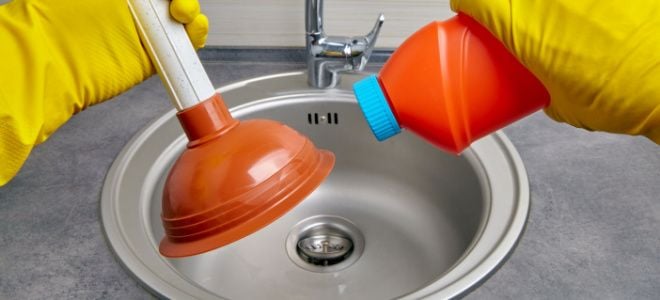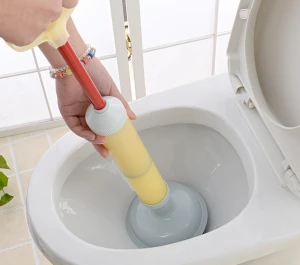The publisher is making a few great annotation relating to Here's How to Correctly Use a Toilet Plunger in general in this great article beneath.

Introduction
Appropriate maintenance of home drains is important for stopping clogs and making sure smooth water circulation. One of the key devices in every house owner's toolkit is the plunger, along with different drain cleansers created to tackle persistent blockages effectively. This post explores just how to use bettors and drain cleansers effectively to keep your drains pipes flowing easily.
Area 1: Understanding Bettors
Sorts of Plungers
There are several kinds of bettors available, each created for different types of drains and obstructs. The most common types consist of mug bettors, flange plungers, and accordion plungers.
Exactly How Plungers Job
Bettors work with the concept of creating pressure and suction to displace blockages. When appropriately applied over a drain, they develop a vacuum that can take out particles or separate blockages.
Choosing the Right Bettor
Picking the best bettor depends upon the sort of drainpipe and the nature of the blockage. Cup bettors are suitable for sinks and bathtubs, while flange plungers are better suited for toilets as a result of their layout.
Typical Mistakes with Bettors
Staying clear of these errors makes sure effective plunging: inappropriate seal around the drainpipe, inadequate pressure, and not clearing bordering particles.
Area 2: Utilizing Plungers Effectively
Prep work
Before diving, make sure the bettor covers the drain completely and develops a tight seal. Clear any kind of visible particles around the drain opening.
Method
Start with mild diving movements to construct suction. Increase stress gradually, making use of a constant rhythm. Repeat as essential till the drainpipe gets rid of.
Troubleshooting Tips
If diving doesn't work, attempt adjusting the seal, using petroleum jelly for a far better seal, or making use of a various type of plunger.
Area 3: Comprehending Drainpipe Cleansers
Kinds Of Drain Cleaners
Drain cleansers can be chemical or chemical. Chemical cleansers use strong chemicals to liquify clogs, while enzymatic cleaners use all-natural enzymes to break down organic matter.
Exactly How Drainpipe Cleaning Company Job
Chemical cleaners react with obstructions to dissolve them, while chemical cleaners break down organic products like hair and grease without damaging pipes.
Security Factors to consider
Always use handwear covers and eye protection when utilizing chemical drainpipe cleaners. Make sure adequate ventilation and comply with maker guidelines thoroughly.
Eco-Friendly Alternatives
Take into consideration making use of vinegar and cooking soft drink or enzyme-based cleansers for environmentally friendly alternatives that are safer for pipes and the atmosphere.
Area 4: Making Use Of Drain Cleaners Effectively
Application Techniques
Pour chemical cleansers straight right into the drainpipe opening. Permit them to benefit the advised time prior to purging with warm water. Chemical cleansers need to rest over night.
Preventative measures
Stay clear of blending different types of cleansers, as this can create hazardous fumes. Never use chemical cleansers in conjunction with a bettor, as spilling can happen.
Dealing With Stubborn Blockages
For consistent clogs, think about using a plumbing serpent or calling a specialist plumber to stop damages to pipelines.
Final thought
In conclusion, understanding just how to utilize plungers and drainpipe cleansers efficiently is important for maintaining healthy and balanced plumbing systems. By choosing the right devices and techniques, home owners can deal with minor blockages and prevent significant plumbing concerns down the line.
5 Steps on How to Use a Plunger Effectively
Creating a Seal: Place the rubber cup of the plunger firmly over the toilet drain hole to create an airtight seal. This seal is crucial to prevent air from escaping and ensure effective plunging.
Plunge Gently: Gently press the plunger down to compress the air inside without causing splashing. This careful action sets the stage for effective unclogging without creating a mess.
Maintaining Pressure: Consistently apply pressure to the plunger while pushing and pulling it up and down. This sustained pressure generates the force needed to dislodge the clog.
Breaking the Clog: Continue plunging until you feel the clog release. Look for the water to start draining, indicating successful removal of the blockage.
Flushing and Cleaning: After clearing the clog, flush the toilet to confirm it's working properly. Clean the plunger with warm, soapy water and disinfect it for future use to maintain hygiene.
Additional Tips on How to Correctly Use a Plunger
if you encounter resistance, add some water to the bowl to create better suction;
check the plunger for any rubber cracks to ensure it's in good condition;
exercise patience and persistence, as certain clogs might need multiple attempts.
Mistakes to Avoid when Using Toilet Plunger
avoid using excessive force, as it may damage the toilet;
don't rush the process; take your time to ensure a proper seal and pressure;
never use a plunger if you've recently used chemical drain cleaners
Conclusion
Mastering the art of how to properly use a plunger is a valuable skill for every homeowner. By employing the correct techniques, you can effectively address clogs and ensure your toilet functions smoothly. Patience, persistence, and proactive in maintaining your plunger's hygiene are key to success in this endeavor.
Armed with these skills and principles, you can confidently handle plumbing issues as they arise, promoting a well-functioning and hygienic home environment.
https://homealliance.com/blogs/how-to-effectively-use-a-plunger-the-ultimate-guide

Application Techniques
Pour chemical cleansers straight right into the drainpipe opening. Permit them to benefit the advised time prior to purging with warm water. Chemical cleansers need to rest over night.
Preventative measures
Stay clear of blending different types of cleansers, as this can create hazardous fumes. Never use chemical cleansers in conjunction with a bettor, as spilling can happen.
Dealing With Stubborn Blockages
For consistent clogs, think about using a plumbing serpent or calling a specialist plumber to stop damages to pipelines.
Final thought
In conclusion, understanding just how to utilize plungers and drainpipe cleansers efficiently is important for maintaining healthy and balanced plumbing systems. By choosing the right devices and techniques, home owners can deal with minor blockages and prevent significant plumbing concerns down the line.
5 Steps on How to Use a Plunger Effectively
Creating a Seal: Place the rubber cup of the plunger firmly over the toilet drain hole to create an airtight seal. This seal is crucial to prevent air from escaping and ensure effective plunging. Plunge Gently: Gently press the plunger down to compress the air inside without causing splashing. This careful action sets the stage for effective unclogging without creating a mess. Maintaining Pressure: Consistently apply pressure to the plunger while pushing and pulling it up and down. This sustained pressure generates the force needed to dislodge the clog. Breaking the Clog: Continue plunging until you feel the clog release. Look for the water to start draining, indicating successful removal of the blockage. Flushing and Cleaning: After clearing the clog, flush the toilet to confirm it's working properly. Clean the plunger with warm, soapy water and disinfect it for future use to maintain hygiene. Additional Tips on How to Correctly Use a Plunger
if you encounter resistance, add some water to the bowl to create better suction; check the plunger for any rubber cracks to ensure it's in good condition; exercise patience and persistence, as certain clogs might need multiple attempts. Mistakes to Avoid when Using Toilet Plunger
avoid using excessive force, as it may damage the toilet; don't rush the process; take your time to ensure a proper seal and pressure; never use a plunger if you've recently used chemical drain cleaners Conclusion
Mastering the art of how to properly use a plunger is a valuable skill for every homeowner. By employing the correct techniques, you can effectively address clogs and ensure your toilet functions smoothly. Patience, persistence, and proactive in maintaining your plunger's hygiene are key to success in this endeavor.
Armed with these skills and principles, you can confidently handle plumbing issues as they arise, promoting a well-functioning and hygienic home environment.
https://homealliance.com/blogs/how-to-effectively-use-a-plunger-the-ultimate-guide

We hope you enjoyed our piece on A Guide to Plungers (and How to Use Them). Thank you so much for finding the time to read our short article. Do you know about someone else who is enthusiastic about the topic? Do not hesitate to share it. I enjoy reading our article about .
Call Today